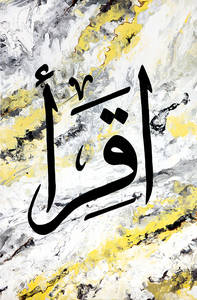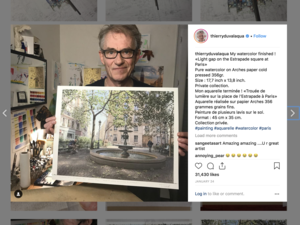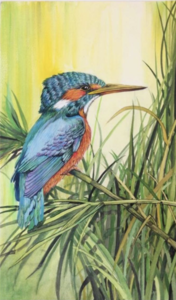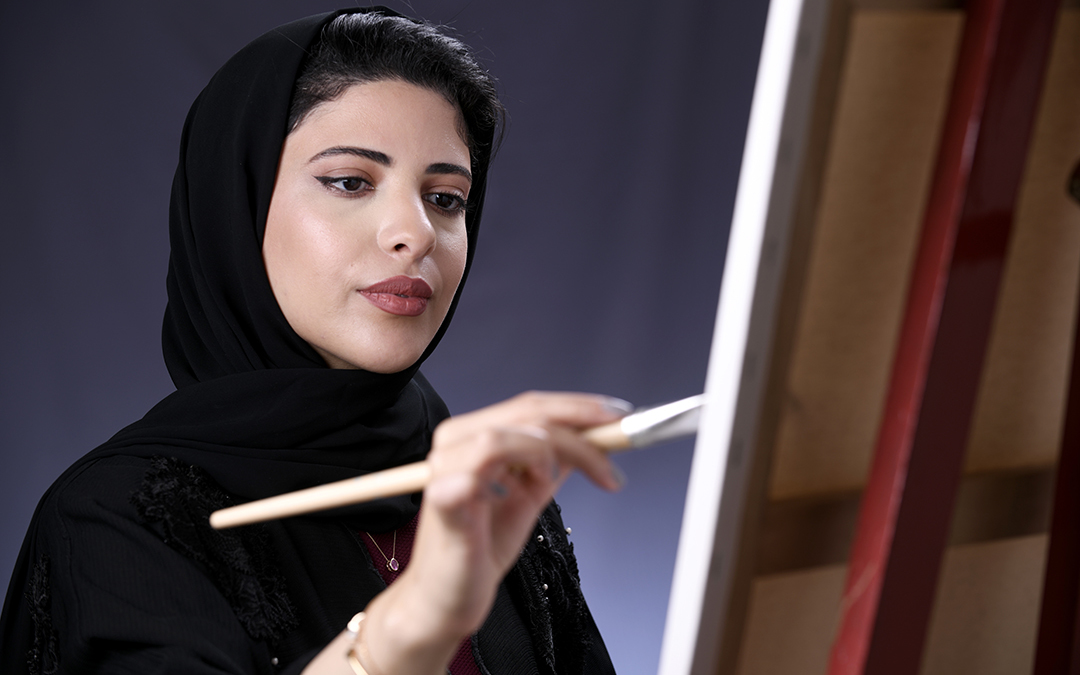Innovations in Global Health Professions Education (IGHPE) recently met with Hanof Ahmed, a Med 4 student at Weill Cornell Medicine-Qatar (WCM-Q), to discuss her experience of art and the humanities while at medical school.
Hanof recently contributed some of her artistic work to Weill Cornell Medicine’s annual journal of humanities, Ascensus. She explained to us why she believes her experience with visual arts enhances her skills as a physician and why she felt it important to set up an art group within the WCM-Q school.

Read by Hanof Ahmed
IGHPE: Tell us about your painting. How did you start painting?
Hanof: I started my journey in art and painting at a young age due to an inherited talent from my mother. I had a natural skill in art, and [when I was] progressing through my schooling, I realized I was constantly being praised for my artwork. My artwork was displayed around the school and I won many art competitions.
So, growing up I felt like I already had the skill, and I developed a love for painting. I realized how amazing it was for me to express myself through this medium, through the color, through the texture and through the lines. I wanted to create my own character and for people to say, “Oh, this is by Hanof,” when they saw my pieces. So I guess this is where the interest really started for me.
What artists inspired you?
I think this is a very difficult question, because I feel like every artist has a different character and a different personality. I think I appreciate the different forms of art and different artists’ works, and I can’t really pinpoint one or two specifically that had an influence on me. Art is really just about experimentation, so it’s nice to see what their take on art is.
For me personally, I really appreciate art that is more of realism or art that portrays a lot of minute details. I really appreciate the skill in the detail and being able to look at the painting and think that it’s a photograph from how realistic it is.

One of my current favorite artists is an artist called Thierry Duval. He’s a French watercolorist who has an insane attention to detail.
Is that the type of art that you create?
Yes, I do. [When I was] growing up, watercolor was my favorite medium to use. I was able to portray a lot of precision, detail and realism using this medium. Then transitioning to the premedical program and having less time, that became challenging for me, because that kind of art requires a lot of time to transform a white piece of canvas into something extremely detailed.
So, at that point I started reverting to other forms of art where I can still have that therapeutic outlet. That was abstract art and being creative with texture and colors. It was the challenge of the thought behind each piece and how to combine many forms of art together. So, for me depending on how much time I had, I was able to do different things and it was fun to experiment, actually, so it was like a nice journey for me as well.
Have you found that you’ve been able to continue doing art a little while you’ve been in medical school? Was that difficult? Did you have to say to yourself I’m going to set aside time for something you felt a need to do?
It was really difficult, I have to be honest. I feel like for me inside, this was something that I really needed to do or had to do, but it’s challenging to find the balance between academic and personal life alongside having time to do these hobbies. And for me, I was involved in a lot of things around college, such as being part of the medical student council, orientation leader and student ambassador. So, it was hard for me to give time for painting and art as I was very active in my college community. Although, this was something that I really wanted to do.
Do you think that your art will make you a better physician? Did it help you in your studies?
Yes, I think that although I haven’t practiced art physically during my medical education, I don’t think that it ever left my side. And having engaged in artistic activities, I feel like it really influenced me and made me a better doctor in terms of creative and critical thinking. You don’t approach a patient as one entity with an objective [in mind] but rather approaching a patient to understand their background as a story. It expands your thinking to include all the different elements that affect the patient’s life through artistic thinking and the artistic mind.
Furthermore, it gave me the upper hand in reading medical images. Medicine isn’t just papers and textbooks, there’s a lot of visual learning. As physicians, we try to see what’s inside the body. Having that artistic eye, I feel that imaging such as x-rays and ultrasounds, for me as an artist, was easier to decipher. I was able to spot the slight differences in intensities and point out the significance of each of the images. I definitely see things differently than other people who may not have engaged in artistic activity. So I think for me, it does make me a better doctor in that sense.
And lastly, the way engaging in art affects you emotionally is important as an aspiring physician. If anything, the action of painting makes you even more ready to “hit the books,” study more, and work harder. Art and painting is really therapeutic and serves as an outlet to release all your energy, hence the term: art therapy. It’s not about studying hard but studying smart.
You contributed to Ascensus, the Weill Cornell Medicine Journal of Humanities, and humanities is embedded within the medical curriculum. What are your thoughts on how humanities are taught within the curriculum – should we include more visual arts?
I think that visual arts are included in very minor proportions. I feel like we can push further for more involvement in the humanities and imbed them in the curriculum. It’s not necessarily just painting, but there are many other forms of arts such as photography, videography, and music, for example, that should be more represented or integrated within the program. As a medical student, the humanities in general were not heavily stressed and the program was very self-directed and specific to the sciences.
I know you set up an art group in Weill Cornell Medicine-Qatar. What has the uptake been of the art group? Do you think it made a difference to some of your peers?
I was really inspired by the effort to engage the Cornell community in the realm of the arts, so I founded the art club. I had a vision of cultivating a culture, an art culture, that serves as an outlet for students and staff who may have not experienced what it feels like to paint or to engage in the world of art. More importantly, I wanted to create opportunities for both artists and non-artists. So, you don’t have to be talented in art to be an artist or engage in painting activities.
I was ecstatic after running a marble canvas painting workshop for students when I received positive feedback from all participants saying how they really enjoyed it and felt relieved by doing something other than studying. They were ready to go back and study for their exams. There was a request for more workshops and more opportunities like this, because it was such a stress-relieving activity for them. This fits in with the implementation of student wellness and creating such activities for the wellbeing of students. This is something that I would love to continue after I graduate.
Hopefully, the Vice President of the club will continue the vision that started the club and hopefully improve medical education through this club. Although the medicine-art connection may not be very apparent, it really does exist. Art and medicine have a huge connection. It’s been a major focus in literature and the media, the way they complement each other rather than conflict.

Hummingbird by Hanof Ahmed
You touched on it earlier, the issue of mental wellness and burnout. It’s clear that it gives you a great deal of pleasure to paint. What would your wish be if you were speaking to somebody who is developing a medical curriculum? How should they integrate the humanities or allow students to pursue opportunities like this?
I think this would be a challenge and it wouldn’t be easy because we’re talking about a change that will focus more attention on the non-academic activities, which becomes difficult in the medical profession. But it’s all about the balance, right?
Furthermore, the culture in college is book-oriented, study-oriented, and research-oriented. Students need to know that they are being supported by taking part in these [humanities] activities because there is an existent culture of “it’s all about the grades.” Similarly to how the institution supports research, they should also have an equal support and push for the humanities and clubs that involve the humanities. And, I as mentioned, it helps students in more than one way as it influences their mental health and wellness in such a rigorous program. Burnout is very prominent among medical students as they progress to the clinical years and have to start taking board exams and so on. So preserving a healthy state of mind becomes crucial. Thus, the humanities should be supported and integrated into the system.
Thank you for your time Hanof. Is there anything that you would like to note in conclusion?
I think it is important to note that art tackles so many different aspects of being an excellent physician. It provides creativity, transforms you to becoming a critical thinker, enhances the patient-doctor relationship, and caters to the emotional well-being and mental health [of the student and physician]. The fact that it tackles so many different things just makes it such an important aspect of medical education.
Thank you for having me talk about this from the student perspective and someone who is strongly passionate about art.

